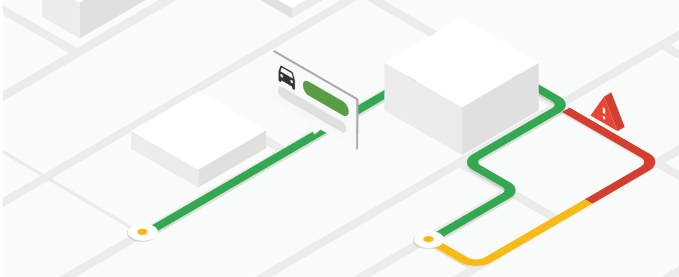
Directions API를 사용해야 하는 이유
Directions API를 사용하면 대중교통, 운전, 도보, 자전거 등 여러 교통수단 모드의 경로를 확인할 수 있습니다.
Directions API로 무엇을 할 수 있나요?
Directions API를 사용하면 다음 세부정보를 비롯한 위치 간 경로를 계산할 수 있습니다.
- 대중교통, 운전, 도보, 자전거 등 여러 교통수단의 경로
- 일련의 경유지를 사용하는 멀티파트 경로입니다.
- 텍스트 문자열 (예: 'Chicago, IL', 'Darwin, NT, Australia'), 장소 ID, 위도/경도 좌표 등 다양한 방법으로 출발지, 목적지, 경유지를 지정합니다.
Directions API 작동 방식
Directions API는 경로를 계산할 때 가장 효율적인 경로를 반환합니다. 제품은 가장 효율적인 경로를 결정할 때 다음 여행 요소를 고려합니다.
- 이동 시간 (기본)
- 거리
- 턴 수
다음 예시 요청은 온타리오주 토론토에서 퀘벡주 몬트리올까지의 운전 경로를 JSON 형식으로 반환합니다.
https://maps.googleapis.com/maps/api/directions/json ?destination=Montreal &origin=Toronto &key=YOUR_API_KEY
리소스
다음 표에는 Directions API를 통해 사용할 수 있는 리소스와 반환되는 데이터가 요약되어 있습니다.
| 데이터 리소스 | 반환된 데이터 | 반환 형식 |
|---|---|---|
| 경로
장소 ID, 주소 또는 위도/경도 좌표 형식으로 출발지와 도착지를 제공합니다. 자세한 내용은 필수 매개변수를 참고하세요. |
경로, 구간, 단계로 구분된 자세한 길찾기입니다. 자세한 내용은 길찾기 응답을 참고하세요. |
|
Directions API 사용 방법
| 1 | 설정하기 | Google Cloud 프로젝트 설정하기부터 시작하여 이어지는 설정 안내를 완료합니다. |
| 2 | 데모 사용해 보기 | API 키와 클라우드 프로젝트가 있으면 경로 데모를 무료로 사용해 볼 수 있습니다. Directions API 데모를 참고하세요. |
| 3 | 요청 빌드 | 요청 예시를 확인하고 이동 수단, 경유지, 경로 제한과 같이 제공할 수 있는 옵션을 알아보세요. 경로 예시를 참고하세요. |
| 4 | 대답의 기본사항 이해하기 | 데이터 응답을 살펴보고 앱에서 경로 데이터를 사용할 준비를 합니다. 자세한 내용은 경로 응답을 참고하세요. |
| 5 | 방향 데이터를 자체 앱에 통합하세요. | 이 데이터를 사용하여 이동 거리와 시간을 계산할 수 있습니다. |
사용 가능한 클라이언트 라이브러리
다음 클라이언트 라이브러리 중 하나를 통해 원하는 언어로 이 API를 호출합니다.
- Google 지도 서비스용 Java 클라이언트
- Google 지도 서비스용 Python 클라이언트
- Google 지도 서비스용 Go 클라이언트
- Google 지도 서비스용 Node.js 클라이언트
Google 지도 서비스용 Java Client, Python Client, Go Client, Node.js Client는 커뮤니티 지원 클라이언트 라이브러리로, Apache 2.0 라이선스에 따라 오픈 소스로 제공됩니다. GitHub에서 다운로드하세요. GitHub에서는 설치 안내와 샘플 코드도 찾을 수 있습니다.
다음 단계
- Directions API 사용 시작하기: 시작하기로 이동합니다.
- 경로 요청 시작하기: 경로 가져오기로 이동합니다.
- 권장사항 따르기: 웹 서비스 권장사항으로 이동합니다.

